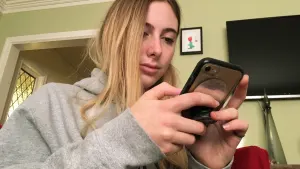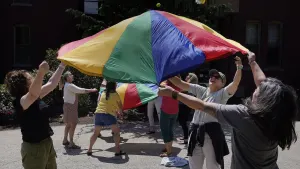More Stories
Pfizer is asking U.S. regulators to allow emergency use of its COVID-19 vaccine, starting the clock on a process that could bring limited first shots as early as next month and eventually an end to the pandemic -- but not until after a long, hard winter.
The action comes days after Pfizer Inc. and its German partner BioNTech announced that its vaccine appears 95% effective at preventing mild to severe COVID-19 disease in a large, ongoing study.
“Our work to deliver a safe and effective vaccine has never been more urgent,” Pfizer CEO Albert Bourla said in a statement.
Not far behind is competitor Moderna Inc.’s COVID-19 vaccine. Its early data suggests the shots are as strong as Pfizer’s, and that company expects to also seek emergency authorization within weeks.
So, what comes next?
1. MAKING THE DATA PUBLIC
The public’s first chance to see how strong the evidence really is will come in early December at a public meeting of the FDA’s scientific advisers.
So far, what's known is based only on statements from Pfizer and BioNTech. Of 170 infections detected to date, only eight were among people who'd received the actual vaccine and the rest had gotten a dummy shot. On the safety side, the companies cite results from 38,000 study participants who've been tracked for two months after their second dose. That's a milestone FDA set because historically, vaccine side effects don't crop up later than that.
“We’ll drill down on these data,” said FDA adviser Dr. Paul Offit of the Children’s Hospital of Philadelphia.
Think of it like science on trial. A few days before the meeting, the FDA will release its own internal analysis. That sets the stage for the advisers’ daylong debate about any signs of safety concerns and how the new vaccine technology works before rendering a verdict.
They’ll recommend not just whether FDA should allow broader use of the vaccine generally but if so, for whom. For example, is there enough proof the vaccine works as well for older, sicker adults as for younger, healthier people?
There’s still no guarantee. “We don’t know what that vote’s going to be,” said former FDA vaccine chief Norman Baylor.
2. EMERGENCY USE ISN’T THE SAME AS FULL APPROVAL
If there's an emergency green light, “that vaccine is still deemed investigational. It’s not approved yet,” Dr. Marion Gruber, chief of FDA’s vaccine office, told the National Academy of Medicine this week.
That means anyone offered an emergency vaccination must get a “fact sheet” describing potential benefits and risks before going through with the shot, she said.
There will be a lot of unknowns. For example, the 95% protection rate is based on people who developed symptoms and then were tested for the virus. Can the vaccinated get infected but have no symptoms, able to spread the virus? How long does protection last?
That’s why the 44,000-person study needs to keep running -- something difficult considering ethically, participants given dummy shots at some point must be offered real vaccine, complicating the search for answers.
And at least for now, pregnant women won't qualify because they weren't studied. Pfizer only recently began testing the vaccine in children as young as 12.
A decision on Pfizer's vaccine won't affect other COVID-19 vaccine candidates in the pipeline, which will be judged separately.
3. WHAT DOES EMERGENCY USE MEAN?
It's when regulators allow shots to be given to certain people while studies of safety and effectiveness are ongoing.
Before any vaccine is permitted in the U.S., it must be reviewed by the Food and Drug Administration, which requires study in thousands of people. Normally, the process to approve a new vaccine can take about a decade. But the federal government is using various methods to dramatically speed up the process for COVID-19 vaccines.
4. MANUFACTURING
Brewing vaccine is more complex than typical drug manufacturing, yet the millionth dose to roll out of Pfizer’s Kalamazoo, Michigan, factory must be the same purity and potency as every dose before and after.
That means the FDA decision isn’t just based on study data, but on its determination that the vaccine is being made correctly.
The Pfizer-BioNTech vaccine -- and Moderna's shots -- are made with brand-new technology. They don’t contain the actual coronavirus. Instead, they’re made with a piece of genetic code for the “spike” protein that studs the virus.
That messenger RNA, or mRNA, instructs the body to make some harmless spike protein, training immune cells to recognize it if the real virus eventually comes along.
5. GETTING INTO PEOPLE’S ARMS
Another government group -- advisers to the Centers for Disease Control and Prevention -- decides who is first in line for scarce doses. Health and Human Services Secretary Alex Azar said he hopes that decision can be made at the same time as FDA’s.
The Trump administration’s Operation Warp Speed has worked with states to line up how many doses they’d need to cover the populations offered vaccine first.
Pfizer will ship those supplies as ordered by the states -- only after FDA gives the OK.
Company projections of how much it will ship each month are just predictions, Baylor warned.
“It’s not like a pizza,” he said. Manufacturing is so complex that “you don’t necessarily end up with what you thought.”
Information compiled with reporting from The Associated Press.
More from News 12
1:28

5 simple steps for long-term benefits to your health and heart
1:32

8 tips for working safely during hot weather
3:31

Guide: Ways to set your child up for financial success
3:18

Guide: The importance of good sleep and how to get it

Guide: Mental health resources available in the tri-state
9:36
